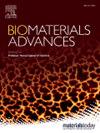Matrix-bound nanovesicles recapitulate tissue-specific angiogenic properties of parent extracellular matrix with distinct miRNA profiles
IF 5.5
2区 医学
Q2 MATERIALS SCIENCE, BIOMATERIALS
Materials Science & Engineering C-Materials for Biological Applications
Pub Date : 2025-05-06
DOI:10.1016/j.bioadv.2025.214338
引用次数: 0
Abstract
Decellularized extracellular matrix (dECM) exhibits tissue-specific pro- or anti-angiogenic effects. Previous studies have demonstrated that matrix-bound nanovesicles (MBVs) act as key bioactive components of dECM, replicating various biological functions such as anti-inflammatory and immunomodulatory effects. Building on this evidence, this study hypothesized that MBVs derived from cartilage and small intestinal submucosa (SIS) modulate angiogenesis through the selective packaging of miRNAs. Cartilage-derived MBVs (cMBVs) and SIS-derived MBVs (sMBVs) were isolated, characterized, and analyzed for their miRNA profiles using RNA sequencing and RT-qPCR validation. The interactions between MBVs and human umbilical vein endothelial cells (HUVECs) were assessed by examining proliferation, adhesion, migration, and tube formation in comparison to the parent ECM. Angiogenic modulation was further evaluated using a mouse Matrigel plug assay and a rabbit corneal neovascularization (NV) model. Our results demonstrated that anti-angiogenic miRNAs (e.g., miR-140-3p, miR-455-5p, and miR-148a-5p) were predominant in cMBVs, suppressing endothelial cell activity and angiogenesis, while pro-angiogenic miRNAs (e.g., miR-143-3p, miR-181a, and miR-21-5p) were prevalent in sMBVs, enhancing vessel formation. In vivo, cMBVs significantly inhibited vascular invasion and neovessel formation, whereas sMBVs promoted angiogenesis in both models. These findings confirm that MBVs reflect the tissue-specific angiogenic regulatory functions of their parent ECM, and highlight their potential as therapeutic tools for targeted modulation of angiogenesis in regenerative medicine and tissue engineering.
基质结合的纳米囊泡具有不同miRNA谱的亲本细胞外基质的组织特异性血管生成特性
脱细胞细胞外基质(dECM)具有组织特异性的促血管生成或抗血管生成作用。先前的研究表明,基质结合纳米囊泡(MBVs)是dECM的关键生物活性成分,具有多种生物功能,如抗炎和免疫调节作用。基于这一证据,本研究假设来自软骨和小肠粘膜下层(SIS)的mbv通过选择性包装mirna来调节血管生成。对软骨源性mbv (cMBVs)和sis源性mbv (sMBVs)进行分离、表征,并利用RNA测序和RT-qPCR验证对其miRNA谱进行分析。与母体ECM相比,mbv与人脐静脉内皮细胞(HUVECs)之间的相互作用通过检查增殖、粘附、迁移和管形成来评估。通过小鼠基质塞实验和兔角膜新生血管(NV)模型进一步评估血管生成调节。我们的研究结果表明,抗血管生成的miRNAs(如miR-140-3p、miR-455-5p和miR-148a-5p)在cmbv中占主导地位,抑制内皮细胞活性和血管生成,而促血管生成的miRNAs(如miR-143-3p、miR-181a和miR-21-5p)在smbv中普遍存在,促进血管形成。在体内,cMBVs显著抑制血管侵袭和新血管形成,而sMBVs在两种模型中均促进血管生成。这些发现证实了mbv反映了其亲本ECM的组织特异性血管生成调节功能,并突出了它们作为再生医学和组织工程中血管生成靶向调节的治疗工具的潜力。
本文章由计算机程序翻译,如有差异,请以英文原文为准。
求助全文
约1分钟内获得全文
求助全文
来源期刊
CiteScore
17.80
自引率
0.00%
发文量
501
审稿时长
27 days
期刊介绍:
Biomaterials Advances, previously known as Materials Science and Engineering: C-Materials for Biological Applications (P-ISSN: 0928-4931, E-ISSN: 1873-0191). Includes topics at the interface of the biomedical sciences and materials engineering. These topics include:
• Bioinspired and biomimetic materials for medical applications
• Materials of biological origin for medical applications
• Materials for "active" medical applications
• Self-assembling and self-healing materials for medical applications
• "Smart" (i.e., stimulus-response) materials for medical applications
• Ceramic, metallic, polymeric, and composite materials for medical applications
• Materials for in vivo sensing
• Materials for in vivo imaging
• Materials for delivery of pharmacologic agents and vaccines
• Novel approaches for characterizing and modeling materials for medical applications
Manuscripts on biological topics without a materials science component, or manuscripts on materials science without biological applications, will not be considered for publication in Materials Science and Engineering C. New submissions are first assessed for language, scope and originality (plagiarism check) and can be desk rejected before review if they need English language improvements, are out of scope or present excessive duplication with published sources.
Biomaterials Advances sits within Elsevier''s biomaterials science portfolio alongside Biomaterials, Materials Today Bio and Biomaterials and Biosystems. As part of the broader Materials Today family, Biomaterials Advances offers authors rigorous peer review, rapid decisions, and high visibility. We look forward to receiving your submissions!

 求助内容:
求助内容: 应助结果提醒方式:
应助结果提醒方式:


